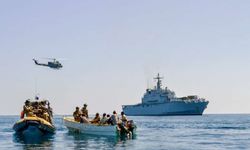The IRGC has warned that additional strikes will follow if Israel retaliates. As tensions escalate, maritime security in the region takes on new significance, with Iran’s naval capabilities playing a crucial role in its strategic positioning.
Media platforms were inundated with videos that captured dramatic scenes of rocket fire illuminating the Iranian skyline.
The Israeli security cabinet is in an emergency bunker in Jerusalem, according to an Israeli source.
Iran is unique in maintaining two distinct naval forces: the Islamic Republic of Iran Navy (Nedaja) and the IRGC Navy (Nedsa). While these forces have different strategic focuses and equipment, together they project Iranian power across regional and, increasingly, international waters.
The regular navy, Nedaja, is a traditional force that primarily operates in the Gulf of Oman, Persian Gulf, and parts of the Indian Ocean. Its fleet consists of aging surface vessels and submarines, some dating back to the era of the Shah. Despite efforts to modernize with new missile and electronic systems, the Navy has experienced multiple mishaps in recent years. Nevertheless, it continues to project a symbolic presence, highlighted by its May 2023 eight-month circumnavigation of the globe with the IRIS Dena and IRIS Makran.
In contrast, the IRGC’s naval wing, Nedsa, operates smaller, faster attack craft that employ swarm tactics and unconventional naval designs, such as missile corvettes like the Shahid Soleimani. Nedsa has extended its reach, with recent deployments in the Indian Ocean and the strategic Straits of Malacca, positioning Iran as a growing naval power.
Iran’s Navy in the Context of Regional Conflict
While Israel’s advanced missile defense systems have thus far intercepted a significant number of projectiles, the presence of Iran’s naval forces adds complexity to the conflict. Iran’s coastal missile boats and submarines, though not as technologically advanced as their Israeli or Western counterparts, pose a significant threat to shipping routes in the Persian Gulf and surrounding areas.
Iran’s ability to deploy naval assets such as the Shahid Mahdavi—capable of launching missiles and drones—further underscores the potential for a naval dimension to the conflict. Although much of Iran’s naval activity has recently “gone dark,” satellite imagery and strategic intelligence suggest that its vessels are actively deployed, possibly in anticipation of further escalations.

Impact on Global Maritime Trade
Given the strategic importance of the Persian Gulf and the Strait of Hormuz—through which a significant portion of the world’s oil passes—any sustained conflict involving Iran’s navy could severely disrupt global maritime trade. Iran has historically threatened to block this vital shipping route in times of heightened tension, and its current naval assets are capable of carrying out such actions.
As the conflict between Iran and Israel unfolds, maritime observers will be watching closely for any signs of naval engagement. For Israel, which maintains a strong naval presence in the Mediterranean, the challenge lies in countering Iran’s asymmetric naval tactics and ensuring the security of its own maritime interests.
While the immediate focus remains on the missile exchange between Iran and Israel, Iran’s naval forces could become a key player in the broader conflict. The dual structure of Iran’s navy allows it to operate on multiple fronts, creating additional security challenges for the region and the global maritime community.







